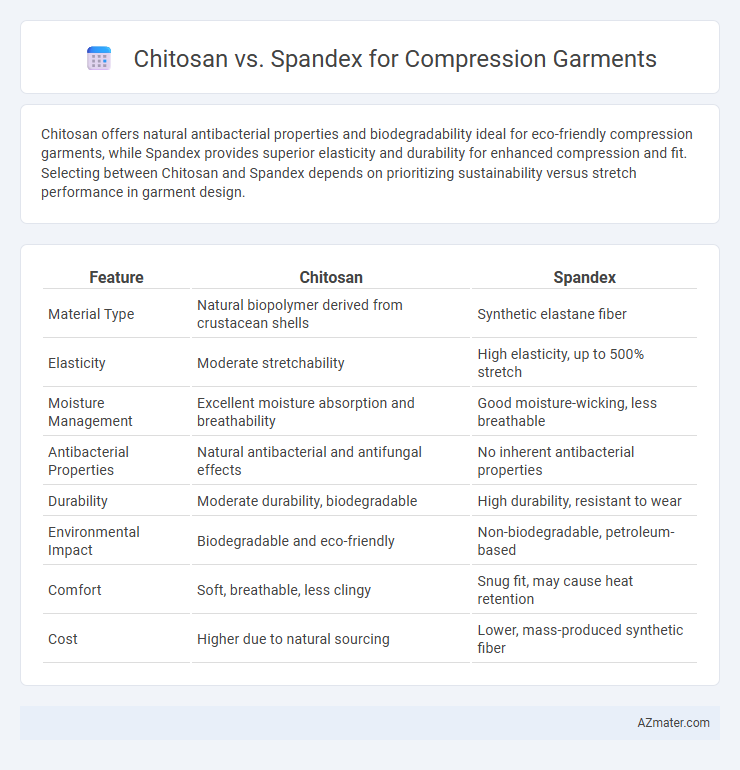Chitosan offers natural antibacterial properties and biodegradability ideal for eco-friendly compression garments, while Spandex provides superior elasticity and durability for enhanced compression and fit. Selecting between Chitosan and Spandex depends on prioritizing sustainability versus stretch performance in garment design.
Table of Comparison
| Feature | Chitosan | Spandex |
|---|---|---|
| Material Type | Natural biopolymer derived from crustacean shells | Synthetic elastane fiber |
| Elasticity | Moderate stretchability | High elasticity, up to 500% stretch |
| Moisture Management | Excellent moisture absorption and breathability | Good moisture-wicking, less breathable |
| Antibacterial Properties | Natural antibacterial and antifungal effects | No inherent antibacterial properties |
| Durability | Moderate durability, biodegradable | High durability, resistant to wear |
| Environmental Impact | Biodegradable and eco-friendly | Non-biodegradable, petroleum-based |
| Comfort | Soft, breathable, less clingy | Snug fit, may cause heat retention |
| Cost | Higher due to natural sourcing | Lower, mass-produced synthetic fiber |
Introduction to Compression Garments
Compression garments utilize materials engineered to apply controlled pressure, enhancing blood flow and muscle support during physical activities or recovery. Chitosan offers natural antibacterial properties and moisture management, making it suitable for compression wear focused on hygiene and comfort. Spandex provides superior elasticity and shape retention, ensuring consistent compression and flexibility essential for athletic and medical garments.
What is Chitosan?
Chitosan is a natural biopolymer derived from chitin, found in the exoskeletons of crustaceans such as shrimp and crabs, known for its biodegradability and biocompatibility. In compression garments, chitosan enhances moisture-wicking, antimicrobial properties, and skin-friendliness, improving comfort and hygiene compared to synthetic fibers. Unlike spandex, which provides exceptional elasticity and shape retention, chitosan contributes to health benefits and eco-friendly performance in medical and athletic compression wear.
Understanding Spandex in Compression Wear
Spandex, known for its exceptional elasticity, offers superior stretch and recovery, making it ideal for compression garments that require consistent pressure and flexibility. Its molecular structure enables garments to conform closely to the body, enhancing muscle support and blood circulation during physical activities. Chitosan, while valued for its antimicrobial properties, lacks the stretchability and resilience of spandex, limiting its effectiveness in providing uniform compression.
Material Properties: Chitosan vs Spandex
Chitosan offers natural antimicrobial, biodegradability, and excellent moisture-wicking properties, making it ideal for breathable compression garments that promote skin health. Spandex provides superior elasticity, exceptional stretch recovery, and durability, essential for maintaining consistent compression and flexibility in activewear. Comparing material properties, chitosan excels in sustainability and skin compatibility, while spandex leads in stretchability and mechanical resilience.
Breathability and Comfort Comparison
Chitosan-based compression garments offer superior breathability due to their natural moisture-wicking properties and antimicrobial effects, enhancing wearer comfort during extended use. Spandex provides excellent elasticity and shape retention but tends to trap heat and moisture, potentially reducing overall breathability and causing discomfort in warm conditions. The choice between chitosan and spandex materials significantly impacts ventilation and skin health, with chitosan garments promoting a cooler, drier experience.
Biocompatibility and Skin Health
Chitosan exhibits superior biocompatibility compared to spandex, as it is a natural polysaccharide with antimicrobial and wound-healing properties that promote skin health in compression garments. Unlike spandex, which is a synthetic fiber prone to causing skin irritation and reduced breathability, chitosan enhances moisture retention and reduces inflammation, making it ideal for sensitive or compromised skin. The incorporation of chitosan in compression garments leads to better skin tolerance and long-term comfort, crucial for medical and athletic applications.
Durability and Longevity
Chitosan-infused compression garments exhibit enhanced antimicrobial properties and improved moisture-wicking capabilities, contributing to prolonged fabric integrity and reduced odor over extended use. Spandex, known for its exceptional elasticity, maintains consistent compression levels through countless stretch cycles, ensuring durability under repetitive strain. Combining chitosan with spandex fibers can optimize both longevity and functional performance in compression wear.
Sustainability and Environmental Impact
Chitosan fibers offer superior sustainability compared to spandex due to their biodegradability and derivation from renewable marine sources such as shrimp shells, reducing reliance on petroleum-based materials. Spandex, a synthetic polymer, contributes to microplastic pollution and has a significant carbon footprint throughout its production and disposal phases. Incorporating chitosan into compression garments enhances eco-friendliness by promoting faster decomposition and lower environmental toxicity while maintaining effective elasticity and compression performance.
Cost and Availability in the Market
Chitosan compression garments typically exhibit higher production costs due to the specialized extraction and processing of chitosan from natural sources like crustacean shells, limiting widespread availability in the market. Spandex, a synthetic fiber known for its elasticity and affordability, dominates the compression garment industry with readily available materials and lower manufacturing expenses. Market presence heavily favors spandex-based garments because of cost efficiency and extensive supply chains, making them more accessible to consumers.
Choosing the Right Material for Your Needs
Chitosan offers natural antibacterial and moisture-wicking properties ideal for sensitive skin in compression garments, while Spandex provides superior elasticity and durability for enhanced movement and long-lasting support. Choosing the right material depends on whether you prioritize skin health and breathability or maximum stretch and compression strength. For athletes or long-term wear, Spandex may be preferable, whereas Chitosan suits those requiring antimicrobial benefits and comfort during extended use.

Infographic: Chitosan vs Spandex for Compression Garment
 azmater.com
azmater.com